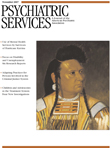Datapoints: Antipsychotic Utilization and Expenditure Trends Among Elderly Persons
Antipsychotic agents, especially second-generation agents, are often used among elderly persons for behavioral symptoms of dementia and psychoses. However, recent trials involving elderly patients with dementia have raised efficacy issues regarding second-generation agents ( 1 ). In the light of these findings, this column examines national utilization and expenditure patterns for antipsychotic agents among the elderly from 1996–2004.
The 1996–2004 Medical Expenditure Panel Surveys (MEPS) were used to derive annual national estimates of prevalence of antipsychotic use and expenditures for antipsychotics among elderly persons in the community aged 60 years or older ( 2 ). All annual expenditures were adjusted to the 2004 dollar value by using the consumer price index.
Prevalence of antipsychotic use remained stable throughout the study period: 1.25% in 1996–1998, 1.27% in 1999–2001, and 1.46% in 2002–2004. Among elderly persons using antipsychotics, the percentage of those taking a second-generation agent increased from 14.65% in 1996–1998 to 72.73% in 2002–2004 (p<.05). Overall, there was consistent increase (p<.05) in the use of second-generation agents: .08 million in 1996–1998, .33 million in 1999–2001, and .53 million in 2002–2004 ( Figure 1 ). Meanwhile, the number of elderly patients taking first-generation agents decreased from .47 million in 1996–1998 to .22 million in 2002–2004 (p<.05).

The annual number of antipsychotic prescriptions increased from 2.59 million in 1996–1998 to 4.26 million in 2002–2004 (p<.05). Total annual antipsychotic expenditure nearly quadrupled from $126 million in 1996–1998 to $483 million in 2002–2004 (p<.05). Annual expenditures for second-generation agents increased nearly tenfold, from $46 million in 1996–1998 to $436 million in 2002–2004 (p<.05). However, expenditures for first-generation agents remained stable, totaling $47 million annually in 2002–2004. Out-of-pocket expenditures increased nearly fourfold, from $60 million in 1996–1998 to $221 million in 2002–2004 (p<.05).
Overall, the prevalence rate of antipsychotic use among elderly persons has remained relatively stable from 1996 to 2004. However, antipsychotic expenditures have significantly increased because of increased use of second-generation agents. In the light of the recent clinical findings and increasing financial burden of antipsychotic agents, the use of second-generation agents among the elderly needs to be optimized.
Acknowledgments and disclosures
The authors report no competing interests.
1. Schneider LS, Tariot PN, Dagerman KS, et al: Effectiveness of atypical antipsychotic drugs in patients with Alzheimer's disease. New England Journal of Medicine 355:1525–1538, 2006Google Scholar
2. MEPS 1996–2004 Full Year Consolidated and Prescribed Medicines Files. Rockville, Md, Agency for Healthcare Research and Quality. Available at www.meps.ahrq.gov/mepsweb/datastats/downloaddatafiles.jspGoogle Scholar



